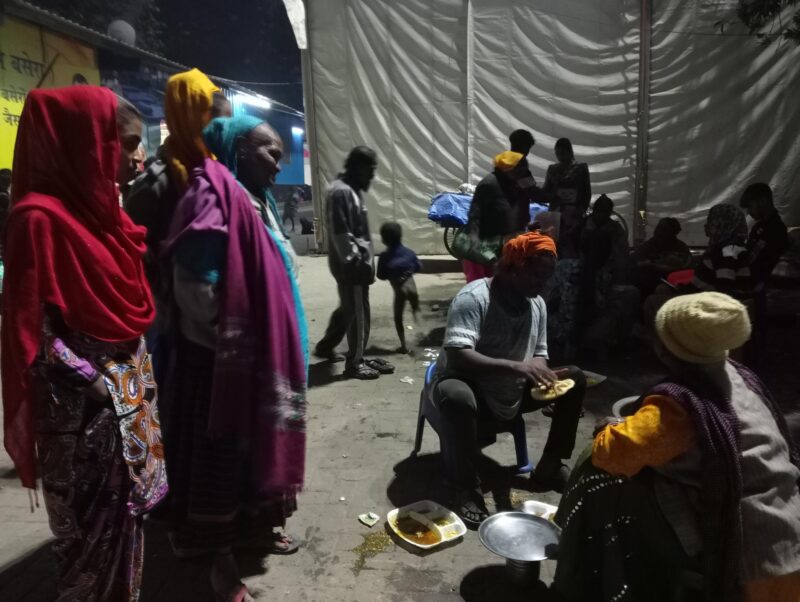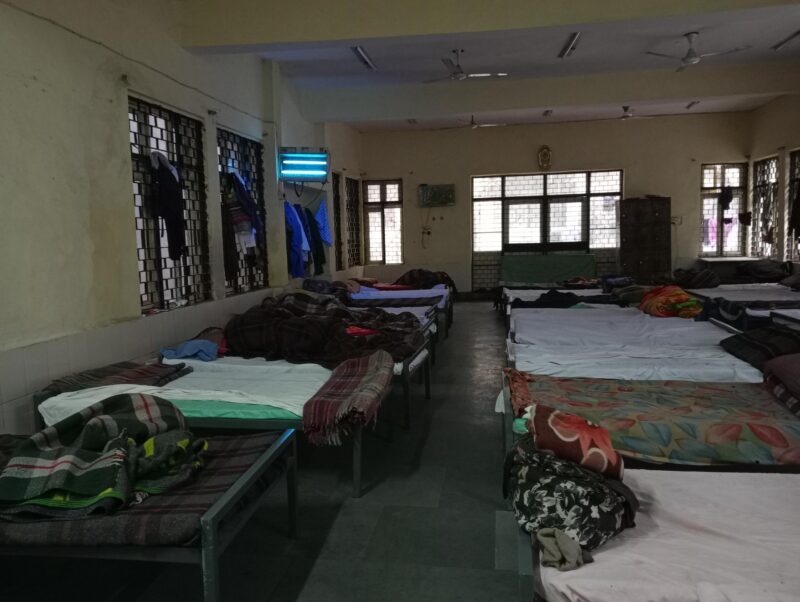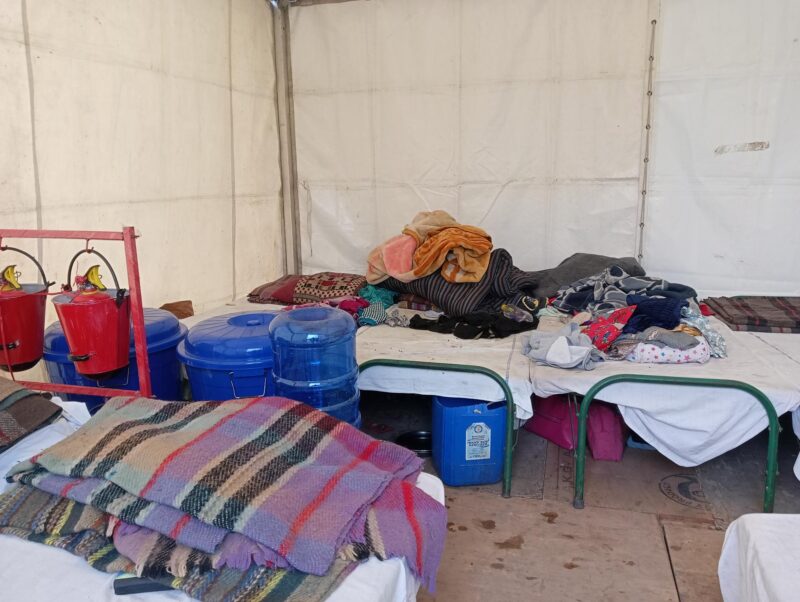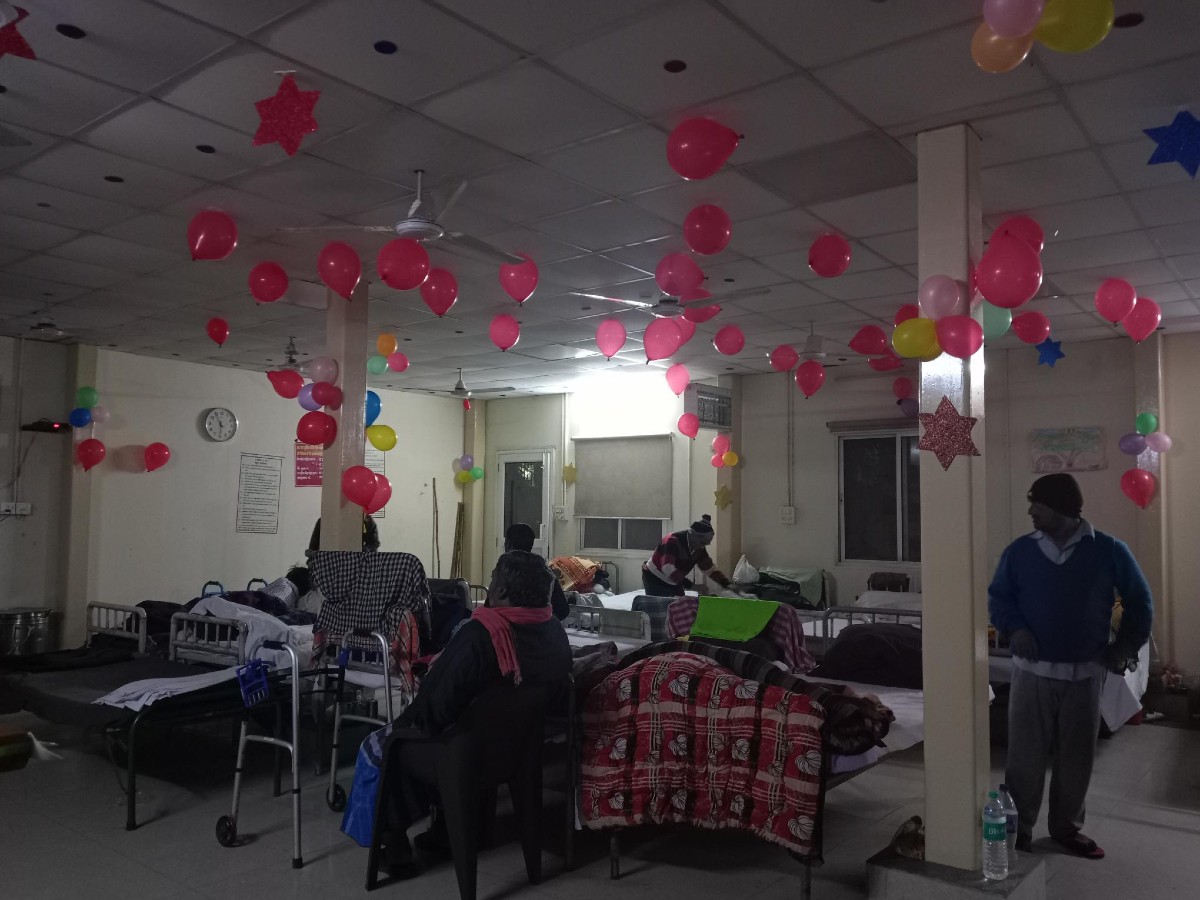For over 35 years, Ruksana has been living in shelter homes in different corners of the national capital. As a child, she used to accompany her parents, both migrant labourers, to their respective work spots such as a construction site, and spend the night either under flyovers or in government-aided shelter homes during Delhi’s freezing winter.
Today, she has her own family, including two children and a husband. Despite all of them working odd jobs, they are forced to live in shelters as “home is still a distant dream”.
“We cannot afford to even rent a room because nothing is below Rs 5,000 and our total earning is somewhere around Rs 15,000. Out of that, we send my in-laws Rs 7,000 in Aligarh,” she said.
Ruksana’s husband, Raju, was born and raised in Aligarh. He arrived in Delhi to make a living and began working at a construction site, where he fell in love with Ruksana and married her three months later.
“We had briefly moved into a one room kitchenback in 2019, but soon after that, lockdown was introduced due to the disease (Covid-19 pandemic) and both of us didn’t get any money for as long as six months. So, we had to leave that place and move back to the streets. Even though work picked up since last year, our wages remained the same and rent of the same places rose,” said Raju, who “regretted” the loss of living under his own roof in Delhi.
Today, their family lives in a Rain Basera (night shelter) in Sarai Kale Khan beside Nizamuddin metro station. Few months ago, they were staying at another shelter.
For Ruksana though, her shifting back to a shelter home has been less painful because there she “found a sister” in Seema.
“We live in the same tent. Hum log agal bagal bistar pe sote hai, raat ko lete lete dil ki baatein kehte hai ek dusre ko (Our beds are next to each other and we pour our hearts out every night). We have formed a sororityhere where we share our own stories of violence and injustice. We don’t feel alone,” Ruksana said.

While 40-year-old Ruksana works as a cleaner at a nearby hotel, Seema is a domestic help, who shifted to the shelter after suffering an injury in her arm from a fall from her bicycle early this year.
The Rain Basera at Sarai Kale Khan has two sections – one is a permanent shelter for the ill and the other is a night shelter particularly set up to accommodate homeless people in winter. It is run by an NGO — Society for Promotion of Youth and Masses (SPYM) — with the help of Delhi government aids.
At least 100 people have taken shelter at the Rain Basera with the arrival of harsh winter. To increase the capacity of the shelter, SPYM has built tents out of tarpaulin making space for 25-26 people to sleep at night. While majority of them are empty during the day as most of those taking shelter are daily wagers, many have made the place their temporary home.
“We get everything here and have no complaints. They give us wholesome meals twice a day and tea once. We get daal and roti/rice as lunch and chhole chawal/roti in dinner. Sometimes we get Chhole Kulche on special occasions. We also have the liberty to cook our food if we want,” said Anju.
Recently, there was Christmas celebration at the Rain Basera. “We try to include everyone in our programmes. No one should feel the dearth of family here. No one is homeless out of choice, but out of compulsion. So, the least we can do is to make people feel at home,” said Nikki, the 32-year-old caretaker.
“Our supplies start coming in early December. We receive atleast 150-200 blankets and additional water tanks because we know people start arriving here by the second week of December as the cold gets more and more bone-chilling. In the permanent shelter, we house those who need treatment and care. If we find anyone lying injured on the road, we immediately send them to the hospital and then bring them here for further care. Few of the tents are only for winter,” he said.
Vijay Kumar has been living there since the first lockdown. He was brought after he suffered an injury in his leg and was wheelchair-bound. Today, he can walk, but not for long distances.
“During winter, when the pain gets worse due to the cold, we are given two to three blankets. I do not know anyone who shivers while sleeping at night here. We are given the best of care,” said Vijay, an orphan who has been living in Delhi as a vagabond.
“The other day (on Christmas), we were greeted with rose and all of us watched the TV together. We do not feel discarded here,” he said.
Few kilometres away, at the night shelter at Kotla Mubarakpur, the situation is similar.
“Since the death of my parents, I have been moving here and there. While I run errands – sometimes at a tea stall and other times at construction sites – I am mostly taking refuge here. We are well-fed here. Even the bathrooms are cleaned daily,” said Rajesh, a migrant from Meerut in UP.

While there were mice rushing around, the inhabitants said that it was of no worry.
“There are rodents everywhere. Especially on the ground floor, even in posh localities, you will find rats because they dig up the ground and come to the surface. You cannot help it, we understand. But, no one has fallen sick eating the food or drinking the water here,” said Manoj, a daily wage labourer who took a day off due to fever.
In Lodhi Road, the Delhi government has set up temporary tents for the homeless to take refuge. Along with water supplies, there are portable toilet set-ups for them. A sense of kinship among strangers was palpable here as well.
While 60-year-old Abbas Ali narrated his story, a young Manjusha (27) fetched him water and a pack of biscuits. “She is like my daughter. My own children have abandoned me since my injury. I was brought here by these people (the caretakers) earlier last month (December). I had been sleeping under the flyover since I met with a major accident back in 2016 and was rendered jobless due to the injury,” he said.
“In the wee hours of April 3 that year, a bus hit me while taking a turn at Nizamuddin. For hours I lay in a pool of blood and was later picked up and taken to the hospital by an NGO, who have been there for me since. I used to be a truck driver, but now I am unable to walk. Even though I am in much better shape now, I cannot walk more than a few metres. Since I have become jobless, my whole family cut ties with me. No one comes to ask for me anymore. It is only these people (the inhabitants in different shelters) who I can now call my own,” Abbas said, breaking down.
During Patriot’s visit, none of those living in such shelters had any complaint against the management or about the arrangement made for them. While most of them were content with food, shelter and water supply, the caretakers hoped for a better pay.

“We know that we mainly work for the NGO, but if the government increases the aid then we will also get an immediate hike in our salaries. We get Rs 20,000 a month and have no leaves. We work almost 360 days a year and hardly ever get to see our families, who live in our home states. Plus, we send almost 80% of our salaries back home. So, if our salaries increase, it will be of great help,” said Vijay Kumar, the caretaker at the Kotla Mubarakpur Night Shelter.
“We care for those taking shelter mainly because we resonate with the migrant workers, living away from home. We put ourselves in their position and work for them because everyone should have a roof above their head,” said Vijay, who hails from Bihar’s Jamui.





